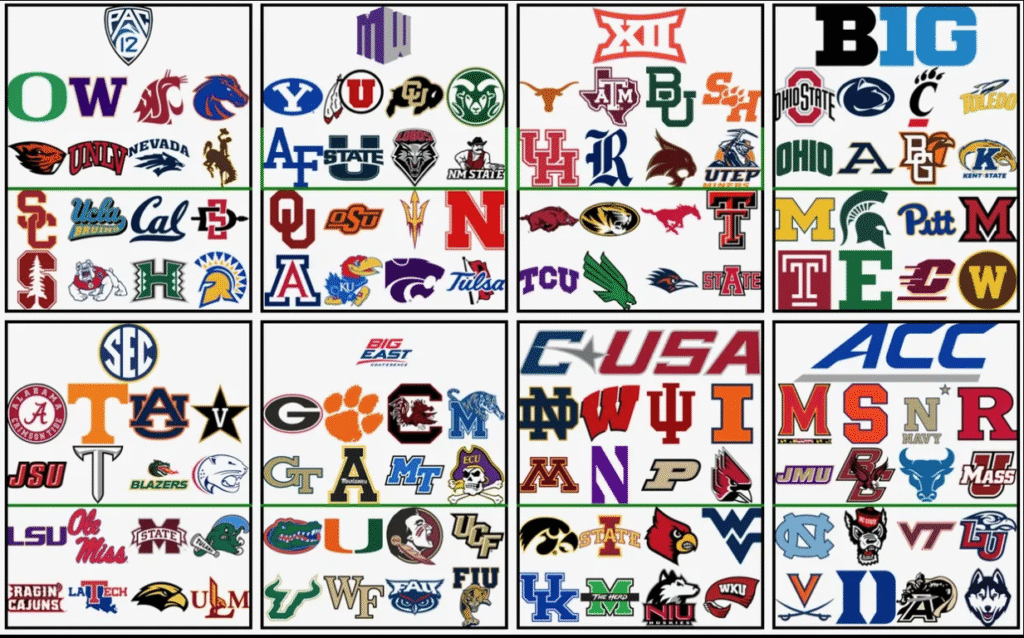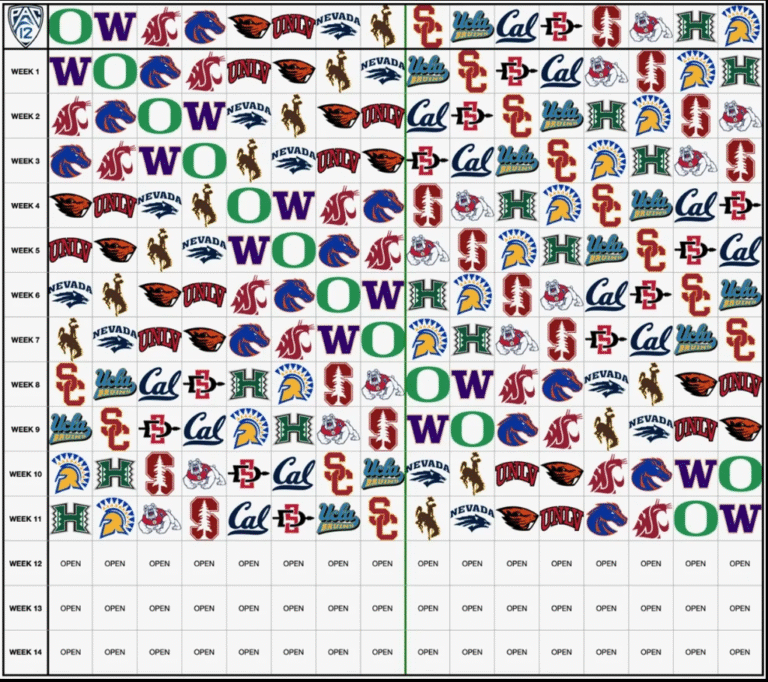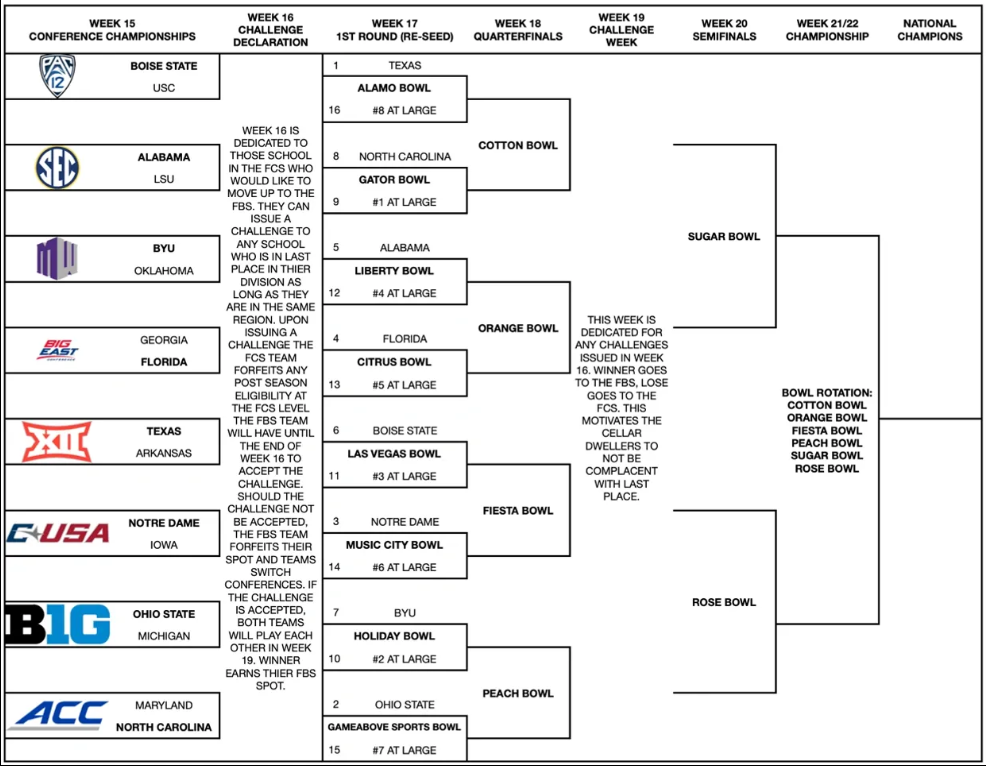
HOW DO YOU FIX COLLEGE SPORTS
FOOTBALL
In Part 1 I covered how I would fix the NIL and Portal in college sports by imposing great penalties for those who would violate the rules and mar the sanctity of the institution and capping NIL and endorsement money all to bring back sanity to college sports. You can read Part 1 here: palevioletred-cobra-758856.hostingersite.com/sts0001
We move on to Part 2 where we will discuss the massive overhaul of college football as we re-align into eight conferences with sixteen teams in each conference, determine who falls from the ranks of FBS, reveal how FCS teams can move up to FBS, decide what roles the polls will play and overhaul the post season to entice star players to compete rather than opt for self preservation.
REALIGNING 10 FBS CONFERENCES INTO 8
We begin with what everyone knows needs to happen already. Conference re-alignment. There is no sense having every power school in one or two conferences beating up on each other and producing lopsided post season championships. There won’t ever be a way to eliminate the possibility of a handful of conferences always winning championships, but we can make it so the playing field is even and all 128 teams have a legitimate shot at achieving greatness. When the Kent States and Purdue(s) of the world can start recruiting with the promise that everyone has an equal shot on day one to make the post season, then, and only then will we see mass overhaul in recruiting and coaching. If you read Part 1 you already know that in this new system I am laying out, there will be caps on NIL and endorsement money so that no one school will ever be able to spend millions upon millions to recruit money hungry teenagers effectively returning the art of recruiting back to coaches and out of the hands of the boosters with big checks.
When I looked at the landscape of all the conferences two things jumped out at me. First, Teams in each conference are spread out all over the place. West coast and east coast in the same conference is just absurd. So I looked at dividing conferences up regionally. But then I was left with one conference having the likes of Alabama, Florida, Georgia, LSU, Tennessee, and Clemson. That didn’t help the argument at all. So I looked into each team’s records and rankings over the last decade and divided them up based on geography and record and came out with 8 regions with fairly even competition between all regions. Not to mention cutting travel expenses by keeping conferences regional.
That didn’t solve the second item that jumped out at me. How will I get rid of six teams and tell the two that are moving up that they don’t get to move up anymore? Tough decisions have to be made and in the end it came down to who contributed the most to college football over the last decade in terms of record, quality of play, and time at the FBS level. The unfortunate decision was made to send Coastal Carolina, Kennesaw State, Delaware, Georgia Southern, Georgia State, Old Dominion, Missouri State, and Charlotte back down to the FCS level. But they do not have to stay there. They can fight their way back into the FBS ranks and I will tell you how a little later.
So what did my research, time, and effort decide what the best way was to divide the NCAA’s most prized possessions? Without any further ado, I present the eight conferences destined for greatness:

CONFERENCE SCHEDULING
Each conference consists of two eight team divisions. Each team in each division will play each other one time in the regular season. Each team will also play four cross divisional teams. That will leave 3 open weeks to schedule any out of conference rivalry games any school wishes to keep alive, tune up games, or they can be left as bye weeks. Here is an example of what a schedule could look like:
In this example, Boise State would play Oregon, Washington, Washington State, Oregon State, UNLV, Nevada, and Wyoming every year while they would play SDSU, California, Fresno State, and Stanford one year and USC, UCLA, Hawai’i, and SJSU the next.

HOW WILL THIS CHANGE THE POST SEASON?
Post season play now becomes expanded. With 8 equally yoked conferences, a single loss or two will not kill any post season chances they might have. The new playoff would be your 16 teams playing in a conference championship game in Week 15. Week 16 would be a bye week. But Week 16 will be reserved for something much more interesting that we will touch on later. Week 17 will be there opening round of the playoffs with your 8 conference champions and 8 at large bids which means the conference champion runner up can still make the playoffs as an at large IF they rank high enough. Week 18 would be the Quarterfinals while week 19 would be a bye week. Like Week 16, Week 19 would be set aside, but more on that later. Week 20 is the Semifinals and Week 21/22 is the Championship Game held on a SATURDAY! For the love of GOD, no one likes the National Championship game held on a Monday. The fix, either play it the week after the Semifinals or give the teams another bye week to prepare for a great showing in the championship game.
WHAT THE HECK IS SO SPECIAL ABOUT WEEK 16 AND 19?
Not yet, but soon. First let’s talk about why the polls will still be important and what will happen to the bowl games and the CFP committee.
Polls will still be important for a number of reasons. They will entice schools to schedule tougher out of conference opponents to bolster their resume should they fall in their conference championship game. With 8 at large spots up for grabs, you cannot rely on in conference success, especially if your conference is having a down year, to determine your worth as an at large bid. Let’s face it, there is no amount of realigning you can do that can factor in every aspect of the game and have the top 16 teams playing in the conference championship games. Not every conference runner up will be guaranteed a playoff spot nor should every conference runner up be selected as an at large. But if you schedule a tough out of conference game or two in your open weeks and lose, you won’t completely torpedo your chances at post season play. If you win your division and your conference championship game, those tough open week losses will only matter when it comes to seeding.
The CFP committee will determine seeding and at large bids using criteria already in place. Conference champions will be seeded one through eight and at large contenders will be seeded nine through sixteen.
Polls will also be used to help the CFP committee determine seeding coming out of conference championship week with the higher seed getting the closest bowl. Much like the NCAA sends higher ranked teams to the closest tournament sites.
Conference championship games would be played at the bowl site chosen by the highest ranked division champion (excluding NY6 and the 8 bowls designated for the opening round). Another scenario would have games played at the home field of the highest ranked participant. All other bowls not associated with the playoffs and conference championship games would then be free to make the best matches possible to be played throughout the rest of the post season. This would be a prime opportunity to cut out the bowls that are money pits or revamp those bowls to draw more lucrative matchups. With only 8 conferences to choose teams from, and the playing field leveled off, there will be better matchups to be had once recruiting levels out. Plus, there is always room for opportunities to have NIL bonuses being paid out to those athletes who choose to participate in these bowl games. You may still get some hold outs from guaranteed first round draft prospects, but for the most part, you could probably retain most of the talent to compete in these bowls. You could even set up a NIT type playoff as well.
NOW ARE YOU GOING TO TELL US WHAT WEEK 16 AND 19 ARE ALL ABOUT?
Yes. Week 16, Week 19, FCS, and the eight schools being kicked from the FBS are all connected. With this new realignment you cannot have an uneven number of teams in each conference or you begin to run into teams wanting to jump conferences all over again. So how do you make it fair for the FCS teams to move up? You let them play for their chance at glory. In Week 16 of each year FCS teams can challenge the last place team in each division in their region for a chance to switch places with them. This means the FCS would have to do some minor adjusting to either realign conferences to mirror the same regions as the FBS or marry existing conferences to their FBS counterparts. In order for an FCS school to challenge, they must be ranked in the Top 25 and they must forfeit any FCS post season eligibility. During Challenge Declaration Week (Week 16) the teams in the FCS Top 25 will have an opportunity to challenge the last place team in each division, starting with the #1 FCS ranked team. If they pass, #2 will have their chance all the way down to #25. If an FBS team declines the challenge, it is an automatic forfeit and the teams will trade places. This ensures that the best teams are playing in the FBS and will provide proper motivation for the cellar dwellers to get better. A team can only issue 1 challenge every 2 years. That challenge must be to a last place team in their region as to not mess with regional travel for conference games. Once the challenge is accepted, the two teams will play at the FBS home field during Challenge Week (Week 19).
Here is a mock up of what a post season might look like with everything in place:

IN CONCLUSION
The best way to make college football more competitive than ever is to re-align the conferences into a mixture of P4 and G5 teams. Divide those conferences into two eight team divisions. Then let them settle who’s best on the field. Conference champions are guaranteed a spot in the playoffs while the runner ups await their fate at the mercy of a committee determining at large bids. Other bowl games can still operate and would be able to attract more lucrative matchups with the playing field being leveled and FCS team will have the ability to move up by challenging FBS cellar dwellers and in doing so, making the FBS more competitive. It is time we make college football about pride, passion, glory, and loyalty again and less about money.
Stay tuned for Part 3 where we overhaul college basketballs post season.
